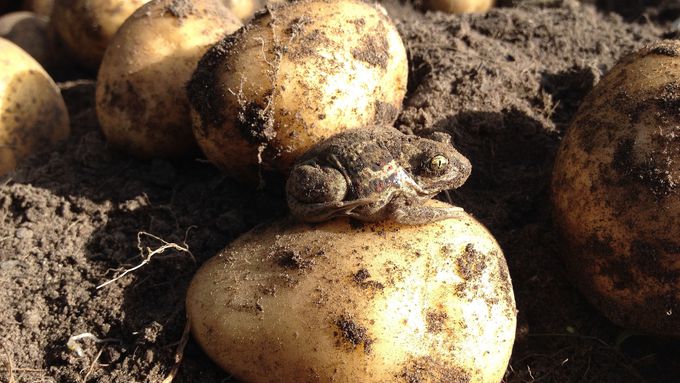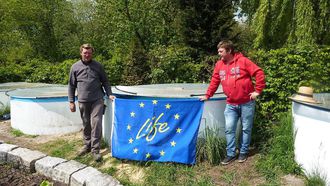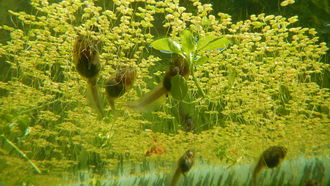Diese Knoblauchkröte wurde im vergangenen Jahr in Braunschweig bei der Kartoffelernte auf einem Acker ausgegraben - dieser war anschließend eigentlich als Baugebiet vorgesehen. © NABU Naturschutzstation
download picturemain content
Project of the month
#1/2018 CONSERVATION BREEDING OF THE COMMON SPADEFOOT
Saving the “Potato Toad”
Most of the year, the common spadefoot (Pelobates fuscus) lives buried in loose soil. Because of this secretive and hidden way of living, it is considered one of the most difficult amphibian species to detect. The species reaches its western distribution limit in Germany and is classified as "Endangered" in the Red List of Threatened Species. In Lower Saxony, the common spadefoot is considered "Vulnerable", in North Rhine-Westphalia even as "Critically Endangered". The species occurs only very occasionally with populations that are quite separated from each other. The population in the former main distribution area in the floodplain of the Ems in the Münsterland has declined sharply; numerous former locations have already disappeared or today are only occupied with a few animals.
In the Atlantic region of Germany, the species was assessed for the 2013 Habitats Report as having an unfavourable conservation status and a negative trend compared to 2007. The observed decline of the species is most likely associated with intensive farming practices in terms of land consolidation and direct loss of spawning waterbodies and terrestrial structural elements. In addition, according to the pilot study "Climate Change and Biodiversity in North Rhine-Westphalia" (2009), the common spadefoot is one of the species which are potentially negatively influenced by climate change. The low mobility of the species hinders migration and successful colonization of new areas. On average, the home range is sized about 100 to 500 meters and migrations of more than two kilometres were observed only in rare cases. For this reason, habitat-improving measures and establishment of an extensive network of the individual populations are extremely important. Numerous corresponding optimization measures for the species are planned within the IP-LIFE.
Another approach for stabilizing smallest remnants, reactivating former occurrences or, in particular cases, establishing the species at new locations within the total distribution area, is population restoration. A rescue breeding program had already been established in an earlier LIFE+ Project (LIFE11 NAT/DE/348 "Preservation of the spadefoot toad in parts of the Münsterland", project duration 2012-2016) by the NABU Nature Preservation Station Münsterland in cooperation with the State Agency for Nature, Environment and Consumer Protection North Rhine-Westphalia (LANUV) and the counties of Warendorf and Borken. This will be developed further under the LIFE-IP and is supposed to be continued over the first two phases of the project.
Preliminary data from genetic studies in common spadefoots across populations in Central Europe revealed only a small differentiation of populations (Eils 2016). Therefore, for breeding adult animals are collected by means of Amphibian fences at different locations in North Rhine-Westphalia. Care is taken to preserve the original genetic diversity as much as possible and to counteract genetic depletion.
The breeding station in Enniger
The breeding station in Enniger in the county of Warendorf is overseen by Michael Bisping and Franz Kraskes. The breeding takes place in circular tanks with a capacity of about 6,000 litres, which are mostly out in the open. The tanks contain flowerpots and bamboo sticks which correspond to the natural spawning structures of the common spadefoot. Spawning takes place at water temperatures above 18 °C. Thereafter, the adult animals are removed from the tanks.
The resulting egg strings can contain up to 2,500 eggs each. The membrane that surrounds the eggs dissolves after a few days. During the first stages of development, the larvae feed on the remnants of the yolk sac. Afterwards, they eat the microorganisms contained in the scum on the water surface, such as paramecia and green algae, as well as daphnia. Older tadpoles mainly feed on plants which do not contain too many bitter substances and are fed with duckweed, wild herbs and organic salad in the breeding station. The best breeding results were obtained with about 300 tadpoles at maximum size in the tanks.
Shortly before the metamorphosis, the tadpoles are transferred to basins that contain both a water area and a land area with good diggable soil. The offspring are released into the wild into the optimized habitats before or during metamorphosis, i.e. with hind legs and usually not yet developed forelegs, but sometimes also as completely metamorphosed young toads, so as to ensure imprinting on the "home waters". The common spadefoot prefers open areas near suitable spawning waters with loose soil into which it can dig deeply. As spawning waters, standing waters which do not run dry are preferred, and which are not too shallow and slightly shaded or sunny and contain aquatic plants for attaching the egg strings.
The planned release sites were examined in advance for suitability as habitat for the common spadefoot whereby in addition to the habitat requirements the long-term availability and protection of the areas played a major role. This risk and feasibility study was conducted accordancing to the IUCN guidelines for reintroduction (2013). For the first phase of the project, releases are planned at five locations within the original distribution in North Rhine-Westphalia: in the Langenbergteich (Paderborn), in the Lippeaue (Lippstadt and Lippstadt-Eickelborn), in Wulfesknapp / Krähenbrink (Lippetal Hovestadt) and in the Rieselfeldern Windel (Bielefeld). In the past year, repeatedly bred tadpoles and metamorphosed young toads were released in the Rieselfeldern Windel as well as tadpoles in the Lippeauen at Soest.
In order to determine the medium-term impact of the releases, so-called monitoring will be carried out in the following years. For this purpose, counts are made for example with the help of Amphibian fences or determined by the number of calling males during nocturnal visits of spawning waters in the mating period.
Related topics
additional information
Further Links
- Website of the LIFE+ Preservation Project for the common spadefoot in the Münsterland (in German) (external link opens in a new window)
- Impressionen aus der Zuchtstation in Ennigerloh (Impressions from the breeding station in Ennigerloh). In: Die Knoblauchkröten (Pelobates fuscus), LANUV-Fachbericht 75, p. 41-62. (in German) (external link opens in a new window)
- Auswirkungen von Klimaänderungen auf die Biologische Vielfalt: Pilotstudie (Effects of climate change on biodiversity) (in German) (external link opens in a new window)
- IUCN/SSC (2013). Guidelines for Reintroductions and Other Conservation Translocations. Version 1.0. Gland, Switzerland (external link opens in a new window)






